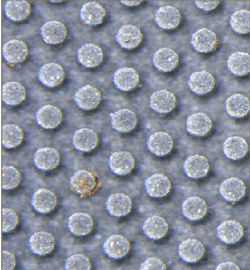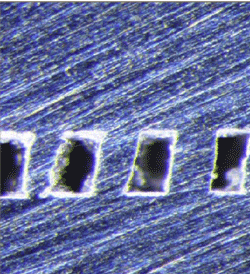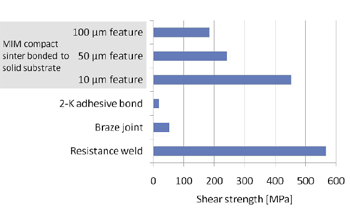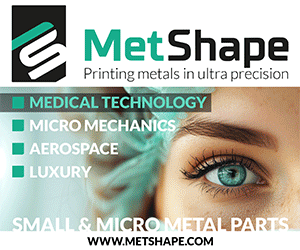New method of sinter bonding PIM compacts to solid substrates developed
February 15, 2011
A new method of sinter bonding powder injection moulded (PIM) compacts to solid substrates has been developed at the Clemson University International Center for Automotive Research (CU-ICAR) in Greenville, SC, USA.
The traditional PIM process has part size and shape limitations. Besides the cost of the feedstock, these limitations are mainly imposed by the debinding and sintering operations. Thick cross sections are difficult to debind or would take too much time to debind and make this process step too cost intensive. Unsupported parts of the compacts can sag during sintering.
These limitations could be overcome by joining the PIM parts with solid parts and create composite parts that could be made of one or multiple materials to satisfy multifunctional design requirements. Advantages of composite parts are that; 1) the amount of powder used can be reduced while maintaining a merit of the PIM process, that is, parts of complex shape can be made easily, 2) parts that are only difficult to make by PIM (for example limited by mould design, cost or size) can be fabricated, for example, by combining a MIM part with a long, thick or thin solid metal, and 3) high mechanical strength or other properties can be acquired only at a necessary portion by using different materials, for example, an alloy steel feedstock and comparatively cheap steel, or other properties such as magnetic and non-magnetic in one part. Each of the above mentioned advantages will also lead to cost reduction.
Sinter bonding a PIM compact to a solid substrate has been considered impossible or very difficult in the past due to the large sinter shrinkage of the powder compact relative to a solid material. This shrinkage would typically lead to cracking in the compact, breaking of the bonded interface, deformation of the compact and, depending on part thickness, deformation of the substrate.
The new method employs a structure of micro features on the surface of the powder component. These features are moulded with the compacts in the injection mould. The powder compact is then placed on the solid substrate and both are joined during sintering.
The micro features allow for post bonding shrinkage through deformation, until the compact reaches its final density, thus avoiding cracks or warping of the bulk of the powder compact.
Fig. 1 shows the micro features on the surface of an injection moulded powder compact. These features can vary in shape and size; in this case they have a circular shape with a diameter of 100μm. Fig. 2 shows a crosscut of a composite part after sinter bonding, with the powder compact on top and the solid part below, joined with the structure seen in Fig. 1.
Tests with 17-4PH powder compacts joined to 17-4PH solid substrates have shown shear strengths of the sinter bonded joints of up to 80% of that of welded joints, as illustrated in Fig. 3. The strength of the joints depend on the size and shape of the micro features.
Email: [email protected]




















